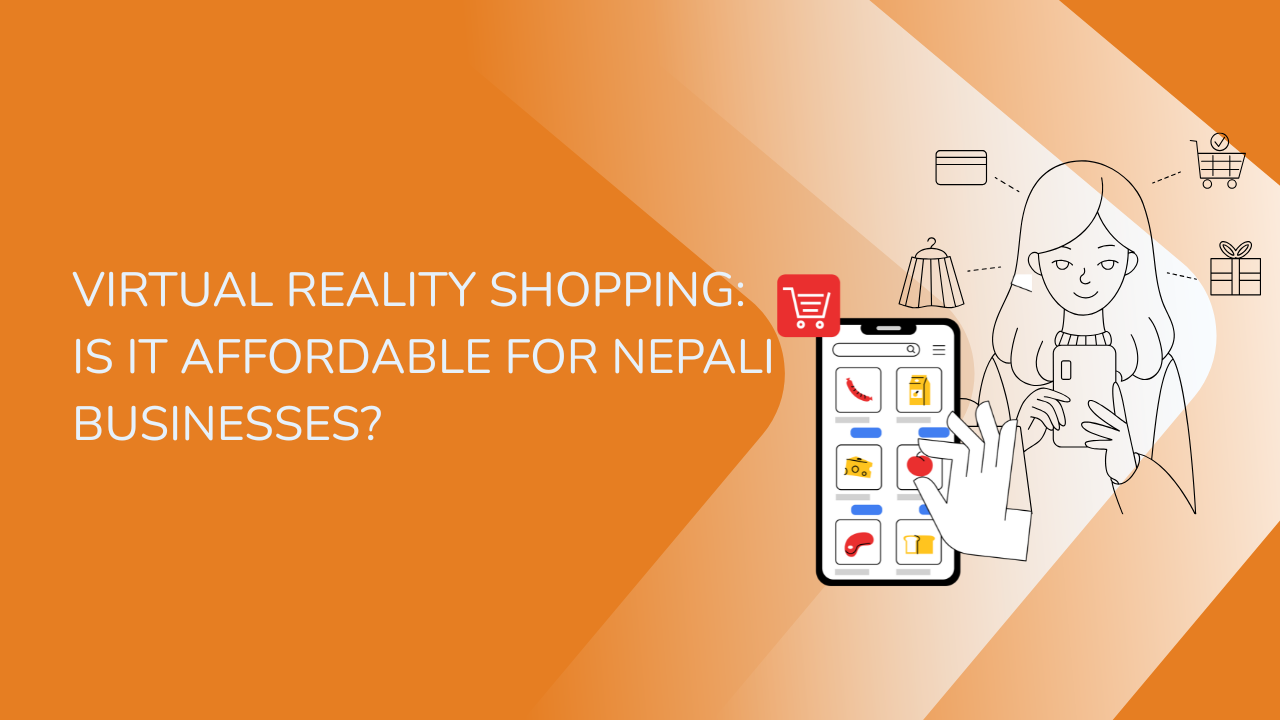Share this Article
The evolution of virtual reality (VR) is reshaping various industries, particularly retail, by offering a unique and immersive shopping experience. In advanced markets, VR storefronts are becoming more popular, allowing consumers to explore products in 3D and experience them before making a purchase. But the question remains: Can Nepali businesses afford to invest in VR shopping experiences, or is it premature for the local market to embrace this technology?
In this article, we explore the potential of VR storefronts in Nepal, evaluating their benefits, challenges, and whether virtual shopping could be a feasible solution for businesses in the country.
Understanding VR Storefronts
A VR storefront is an online store that utilizes virtual reality to create a fully interactive, immersive shopping experience. Through VR headsets, customers can explore a 3D representation of a store, view products in detail, and, in some cases, try items virtually. This new approach mimics the in-store shopping experience, providing a more engaging way to shop compared to traditional online stores.
In countries with advanced digital infrastructure, VR shopping is gaining traction, with brands like IKEA and Walmart using VR to enhance their retail operations. But what does this mean for Nepal, where digital shopping is still growing?
The Global Surge of VR in Retail
Global retail giants have started to embrace VR, integrating it into their customer experience strategies. Companies like IKEA use VR to help customers visualize furniture in their homes, while VR marketplaces like Decentraland offer a digital environment where people can shop for a range of products, including virtual goods.
This trend is driven by innovations in VR technology and the growing preference for immersive online shopping. As people continue to adapt to online shopping, the demand for more interactive and personalized experiences is also on the rise. However, the question is whether Nepali businesses can benefit from these same technologies.
Why VR Storefronts Could Benefit Nepali Retailers
Despite the potential challenges, VR storefronts present several advantages for Nepali businesses in the retail sector:
1. Improved Shopping Experience
One of the primary benefits of VR storefronts is the enhanced shopping experience they offer. In Nepal, where traditional retail methods dominate, VR could help businesses stand out by providing a more engaging and interactive way for customers to shop. Instead of browsing static images, consumers can explore 3D representations of products, viewing them from various angles and interacting with them in ways that feel similar to being in a physical store.
This immersive experience could attract tech-savvy customers and improve satisfaction by offering a richer, more detailed way to shop.
2. Reaching a Broader Audience
For businesses in Nepal, VR can break geographical barriers, allowing retailers to reach customers in both urban and rural areas. Rural customers, who may not have access to urban retail centers, can shop virtually and have products delivered to their doorstep. This can open up new markets, allowing Nepali businesses to expand their reach significantly.
While traditional physical stores limit a business’s market, VR stores offer the chance to access customers from across the country without worrying about location constraints.
3. Lower Operational Costs
Starting a VR store may be costly initially, but it can offer long-term savings. By moving products online and creating a digital storefront, businesses can reduce costs associated with maintaining physical stores, including rent, utilities, and on-site staff. VR stores don’t require physical space to display products, allowing for a wider range of items without the logistical limitations of traditional retail spaces.
Moreover, VR platforms can automate customer service using virtual assistants, reducing the need for large teams of customer support staff.
4. Standing Out in a Crowded Market
In a competitive retail environment, differentiation is key. Adopting VR technology could give Nepali businesses a distinct edge. By offering an innovative shopping experience, businesses could attract early adopters and tech enthusiasts who appreciate new and unique ways of shopping.
Being a pioneer in VR shopping could help businesses build brand recognition and customer loyalty as they are seen as leaders in embracing cutting-edge technology.
Challenges for Nepali Businesses in Adopting VR Storefronts
While the concept of VR storefronts is exciting, it comes with a set of challenges that Nepali businesses will need to navigate:
1. High Initial Investment
The biggest challenge for most Nepali businesses is the significant cost associated with setting up a VR storefront. Developing a VR platform requires investing in both hardware and software, including VR headsets, motion sensors, and 3D modeling tools. For small and medium-sized enterprises (SMEs), this initial investment can be daunting.
For businesses that are still building their online presence, the cost of creating a VR store may outweigh the potential benefits, especially when more affordable and less complex e-commerce solutions are available.
2. Limited Access to VR Hardware
While smartphones and laptops are widespread in Nepal, VR hardware remains expensive and inaccessible for many consumers. To experience a VR storefront, customers would need VR headsets, which are not widely available in the Nepali market. This creates a gap, as businesses offering VR shopping would have a limited audience unless VR hardware becomes more affordable and accessible.
As of now, the majority of Nepali consumers still rely on their smartphones for digital shopping, making it difficult for VR to gain widespread acceptance.
3. Connectivity and Digital Literacy
Nepal’s internet infrastructure, although improving, still faces challenges. Many areas, especially rural regions, experience slow or unreliable internet connections, which may impact the performance of VR applications that require fast, stable internet. For VR shopping to work smoothly, high-speed internet is essential, making it difficult for many consumers to fully enjoy the experience.
Additionally, digital literacy remains a concern in Nepal. Many consumers, especially in rural areas, may not be familiar with VR technology or may find it challenging to navigate virtual shopping environments. Educating consumers and providing easy-to-use VR platforms will be essential for the success of VR shopping in Nepal.
4. Content Creation and Maintenance
Building and maintaining a VR storefront involves the ongoing creation of high-quality, detailed content. This includes 3D modeling products, ensuring accurate representation, and keeping the virtual store up-to-date. For businesses, particularly small ones, the resources required to create and manage a VR store could be prohibitive.
The creation of immersive and high-quality VR content demands technical expertise and investment in software and training, which can be a barrier for businesses with limited resources.
Is Virtual Shopping Feasible for Nepali Businesses?
Although the concept of VR storefronts is exciting, the current realities in Nepal—such as high initial costs, limited access to VR hardware, and digital infrastructure challenges—make it unlikely that most Nepali businesses will adopt this technology in the immediate future. For many small and medium-sized businesses, focusing on improving their existing online presence may be a more practical step.
However, as VR technology becomes more affordable and widespread, there is potential for it to play a role in Nepal's retail future. In the long term, as the digital infrastructure improves and consumer behavior shifts, VR could become a more accessible and valuable tool for businesses looking to enhance their retail experience.
Conclusion
Virtual storefronts represent an exciting possibility for Nepali businesses to offer innovative, immersive shopping experiences. While the initial investment and current limitations may make it difficult for most businesses to implement VR shopping in the short term, there is potential for the technology to become a key player in Nepal’s retail sector in the future. As digital infrastructure and VR accessibility improve, businesses that embrace this technology could differentiate themselves and stay ahead of the competition, providing a unique and engaging shopping experience to customers.
Categories:
E-commerce Tips & Tutorials
,
Marketing & Growth
,
SEO & Content Marketing
,
Beginner’s Guides
,
Sales & Conversion
,
Success Stories & Case Studies
,
Platform Features & Updates
Tags:
Online Store in Nepal
,
5 Simple Steps
,
local businesses
,
e-commerce app
,
Small Business
,
strong brand
,
E-commerce







